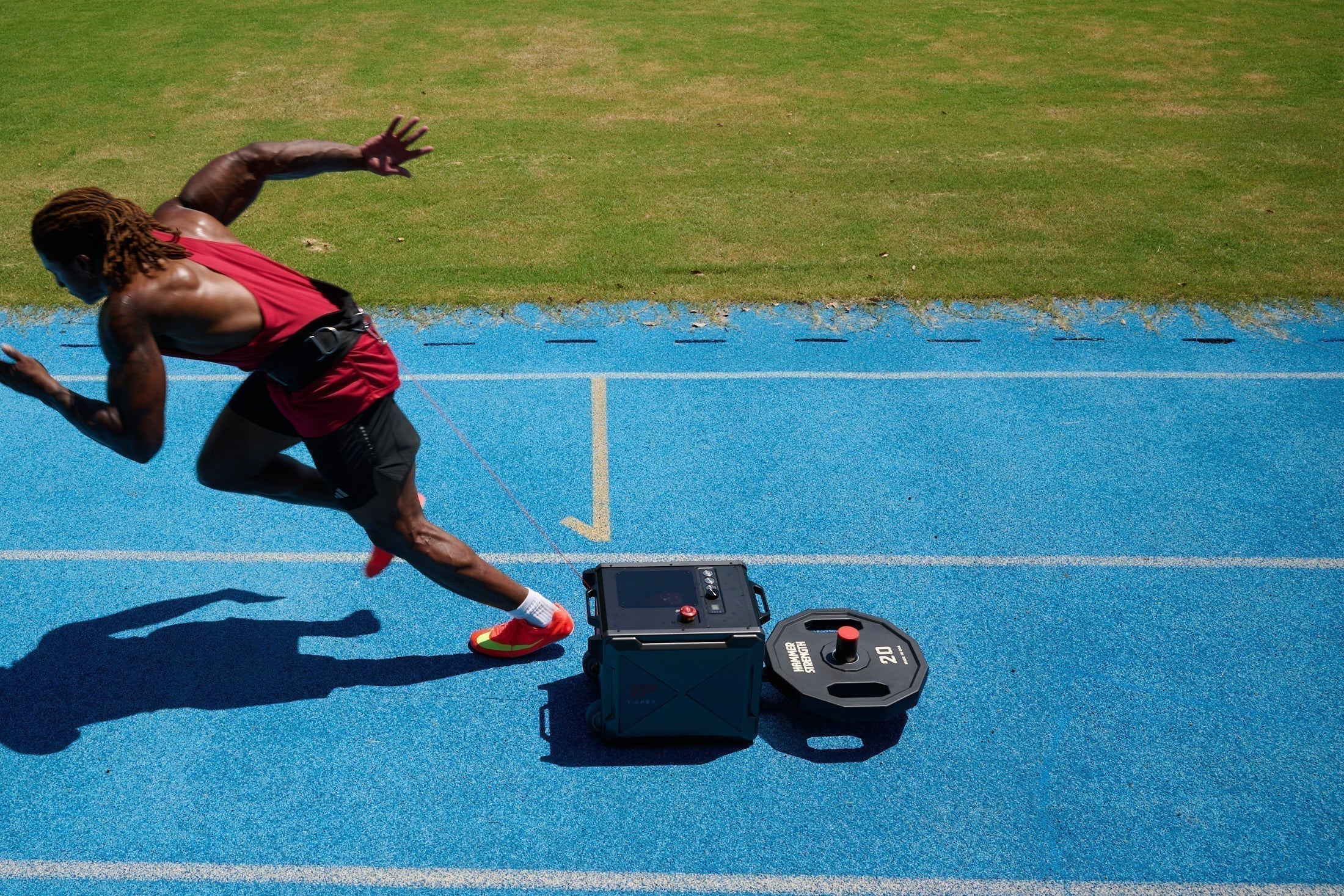Intro — The Demands of American Football
American football is an intermittent, high-intensity, power-dominant sport. Each play lasts only 4–8 seconds, performed at maximum effort, followed by 20–40 seconds of partial recovery before the next snap.
Within those few seconds, athletes must explode off the line, change direction, absorb contact, and re-accelerate — all while reacting to the play in real time. It’s not an endurance contest but a test of how efficiently power can be generated, controlled, and reapplied.
T-APEX brings these demands into a single adaptive training system. Its smart resistance responds instantly to movement speed and direction, allowing coaches to target acceleration, braking, and rhythm work for every role on the field.

These demands make American football one of the most complex sports to train for — and where smart, adaptive resistance becomes a game-changer.
The Challenge — Precision Training for Every Role
Football training targets many physical qualities — power, speed, rhythm, and control — yet most programs divide them across different tools and sessions. Athletes lift for strength, sprint for speed, and perform agility drills for coordination. The methods work, but the connection between them often gets lost.
Each component functions in isolation, making it difficult to track how strength transfers to game-speed movement or how rhythm shapes acceleration efficiency. And while effort can be felt, it’s rarely measured in a consistent, data-driven way.
Because football is a team of specialists, each position demands its own athletic profile:
- Skill players (WR, RB, DB) rely on acceleration, agility, and reactive speed.
- Power players (OL, DL) depend on short-range force, stability, and core strength.
T-APEX simplifies this challenge. Within one system, coaches can train explosive drive, deceleration, stability, and tempo — all under measurable resistance. No switching equipment, no guessing. Every session connects the dots between strength, rhythm, and real game movement.
Instead of switching tools for every skill, coaches can use one system — T-APEX — to build acceleration, deceleration, rhythm, and positional power with measurable precision.
How T-APEX Adapts to Each Role
| Position | Training Focus | T-APEX Application | On-Field Benefit |
|---|---|---|---|
| RB / WR | Explosive start and re-acceleration | Low-angle resisted sprint + assistance mode | Faster separation from defenders and smoother post-catch acceleration |
| DB | Reactive deceleration and quick cuts | Isotonic resistance with delayed braking | Sharper direction changes and quicker coverage recovery |
| OL / DL | Core stability and short-range power | High-resistance, low-velocity mode | Stronger base, improved blocking control |
“There’s a technique to acceleration — T-APEX basically forces you into that forward-lean sprint posture.”
— WR, Shanghai Warriors
Each drill mirrors real game tempo — turning physical strength into repeatable, position-specific power.
Key Metrics That Drive Real Results
Smart resistance turns every sprint into measurable feedback. Instead of relying solely on observation, coaches can see exactly how efficiently a player moves — and how long they can sustain it. Four key data points provide real-time insight into both performance and fatigue trends.
- Peak Velocity — Tracks how quickly an athlete reaches top speed. A drop across reps may signal fatigue or technical inefficiency.
- RMS (Average Power) — Indicates rhythm and stability. Consistent RMS reflects steady propulsion and endurance under resistance.
- Time to Peak — Measures neural reactivity and movement efficiency. A shorter time shows improved explosiveness and stride control.
- Distance to Peak — Reveals spatial efficiency. Less distance means the athlete accelerates faster and reaches optimal rhythm sooner.
These numbers give context to what coaches already see — turning subjective evaluation into quantifiable progress.
Data turns every rep into feedback — measurable, actionable, and specific to each athlete’s role.
Inside the Training: Example Drill Breakdown
Drill: Low-Angle Resisted Sprint (Wide Receiver Acceleration)
- Setup: 10 m sprint with isotonic resistance (3–4 kgf), belt anchor at waist height.
- Objective: Reinforce first-step drive and early-phase acceleration under controlled resistance.
-
Key Metrics:
- Peak Velocity — evaluates start efficiency and drive strength.
- Time to Peak — reflects how quickly maximum velocity is reached.
Interpreting the Data: As the Time-to-Peak number drops and the speed curve evens out, it shows the athlete is syncing movement and muscle activation more efficiently. With repetition, those small gains add up — cleaner take-offs, faster transitions, and smoother acceleration when the game is live.

This is where data meets instinct — turning every sprint into a measurable, repeatable step toward faster, more controlled performance.
Summary — Turning Precision into Power
T-APEX brings position-specific precision to one of the most physically demanding sports on earth. From receivers chasing milliseconds to linemen anchoring collisions, the same smart resistance system adapts to every role — making rhythm, control, and power part of one continuous process.
“In games we’re often sprinting while someone’s hanging on us — high resistance, but still full speed. T-APEX lets us simulate that exact feeling in training.”
— RB, Shanghai Warriors
It’s not just resistance; it’s intelligent load management, where strength and speed finally meet.

